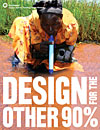Design for the other 90% controversy
Stairs identifies three crucial problems:
“Remote experience is, consequently, one of the issues curators face in mounting such an exhibition, and it is a price we, in the West, pay for our mediated existence. Too often design solutions are remote solutions, even by those with years’ work in the developing world (myself very much included). The only reference I could find in the catalog to this problem was Martin Fisher’s observation that poor families like to prepare their main meal indoors in the evening, when solar cookers are considerably less effective — an issue contradicted in exhibiting a solar stove made from bicycle parts.
A second fallacy afflicting design thinking is what I call instrumentalization, or the notion that technology can, more often than not, provide the solution. Designers are especially susceptible to this delusion, perhaps because they are often trained to solve immediate rather than long-term problems. By way of example, inventions like the Hippo and Q water rollers work well at alleviating hard work over level ground, but are less effective than a jerrycan headload over meandering, hilly, narrow footpaths. Or, the exhibition’s catalog shows an Indian man in a workplace illuminated by a solar lighting system, but ironing clothes with a charcoal-heated iron. Similarly, the PermaNet — a specially-treated mosquito net — repels bugs for twice as much time as conventionally-treated nets. Regrettably, as it was displayed in the exhibition, it did not reach the ground; this is precisely the real-world oversight that heat-seeking vectors take advantage of in Africa.
Gargantuan thinking is a third error: the need to house the world’s population, eliminate disease, and reverse global warming. (Here I much prefer Wes Janz’s onesmallproject to Bruce Mau’s Massive Change.)”
Stairs concludes:
“Is there a realistic response designers from developed countries can offer? A starting point might be to recognize that in many cases, we don’t need to remake other people or their societies in our image and likeness. The idea of design intervention — sustainable or otherwise — may feel very intrusive to people who are still reeling from 150 years of colonial intervention. (You don’t just waltz into a patriarchal society and aggressively advocate equal opportunity for women, or deliver pumps and boreholes to peasant farmers without understanding the sociology of migratory herdsmen). Living among other people and learning to appreciate their values, perspectives and social mores is an excellent tool of design research. (To their credit, both Polak and Fisher have spent considerable time abroad, not just user-testing, but living and working with their client-partners.) Education is also a wonderful access point, as is a required second language. But how many design curricula are supporting, let alone implementing such global initiatives?”
The article got 58 comments so far and was featured on the Core77 webzine.
David Stairs coordinates the graphic design program at Central Michigan University. He is the founding editor of Design-Altruism-Project, and the executive director of Designers Without Borders.





Such a very good site and thanks for information.